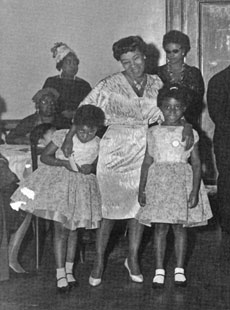Sifting through generations
Michele Wallace explores personal and political experiences

Michele Wallace is under her grandmother Willi Posey’s left arm; her sister Barbara is under the right. Their mother, Faith Ringgold is behind, in dark glasses. Image from Dark Designs and VIsual Culture, 2004.
For her lecture entitled “Talking Pictures: Black Feminist Generations,” Michele Wallace mined her family photo albums for the personal and political clues they provided to the last two centuries of African-American experience.
Wallace has established herself as a cultural critic with a series of volumes, most recently Dark Designs and Visual Culture. The decision to explore her family through images came naturally to her, “We communicate in my family through pictures,” she said.
The address was both the annual Mary Ann Beckett-Baxter Memorial Lecture and the keynote speech for this year’s graduate student conference on visual culture. It brought 17 speakers from across North America to Concordia March 17 to 18 under the theme Shifting Borders. Presenters addressed themes of mapping, borders and shifting between media.
Wallace, currently a Visiting Professor of the Africana Research and Study Center at Cornell University and a Professor at City University in New York, was introduced by Simone de Beauvoir Institute Principal Lillian Robinson.
Robinson commented on Wallace’s career of shifting borders and pushing limits, back to the latter’s first book, Black Macho and the Myth of the Superwoman. Wallace ignited a controversy with her book, which took the Black Power movement to task in the1970s for neglecting women.
In true feminist tradition, Wallace’s lecture interjected the personal into the political context of her family, images of relatives who were slaves and who helped establish black schools during Reconstruction. She apologized for the quality of some of the prints, confessing that her (now 75-year-old) mother was possessive about pictures and these were the ones she had been able to pilfer.
The lecture was divided into two parts, the first tracing generations of Wallace’s family back to 1830 through her mother’s mother’s ancestors. The second set of slides depicted the work of Wallace’s mother, Faith Rin-gold, an established visual artist. Most intriguing were the ways in which relatives, recognizable from their photographs, resurfaced in much of Ringgold’s art.
Wallace’s ancestors learned quilt-making and sewing while slaves. Those traditions were passed down to Wallace’s grandmother, Willi Posey, who became a dressmaker and designer in Harlem. This explains Ringgold’s increasing use of soft sculpture and quilt-making as a medium for her art.
Wallace showed a quilt triptych her mother had sewn in 1985, Street Story Quilt #1,2,3, now part of the Metropolitan Museum of New York’s collection. The squares depict a series of tenement windows framing often disturbing stories. Wallace understood those images when she realized that the block her mother had grown up on in Harlem was known for having the highest number of shootings of police officers in the city.
Wallace now teaches on a campus some six blocks away.
Family relationships also marked the lecture. As Wallace pointed out, “the women in my family are performers.” Wallace stopped at one photograph featuring her mother and aunt with wide smiles and impeccable outfits. “This photo must have been staged. We have a smile in our family that means ‘for the public’. I’m the only one who can’t do it.”
The relationship between public and private, art and life, history and the present were among the borders repeatedly presented and shifted in Wallace’s lecture.
Shifting Borders was organized by eight Fine Arts graduate students. Organizer Reid Cooper acknowledged the support they received from professors Loren Lerner, Catherine MacKenzie and Martha Langford.
